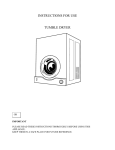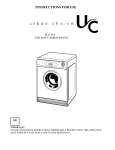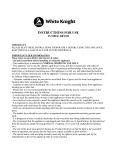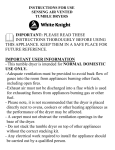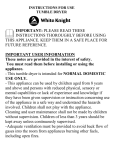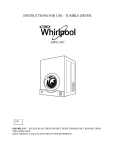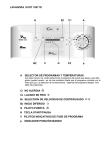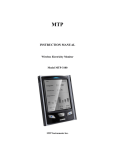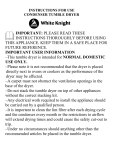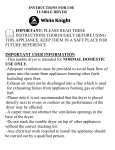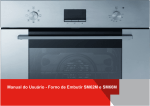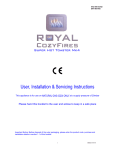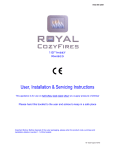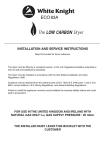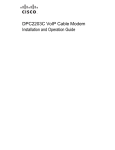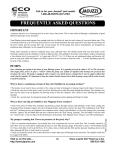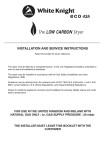Download White Knight C44A7W tumble dryer
Transcript
INSTRUCTIONS FOR USE TUMBLE DRYER IMPORTANT PLEASE READ THESE INSTRUCTIONS THOROUGHLY BEFORE USING THIS APPLIANCE. KEEP THEM IN A SAFE PLACE FOR FUTURE REFERENCE. IMPORTANT USER INFORMATION –This tumble dryer is intended for NORMAL DOMESTIC USE ONLY. - Adequate ventilation must be provided to avoid back flow of gases into the room from appliances burning other fuels. Including open fires. - Exhaust air must not be discharged into a flue which is used for exhausting fumes from appliances burning gas or other fuel. –Please note it is not recommended that the dryer is placed directly next to ovens or cookers as the performance of the dryer may be affected. –A carpet must not obstruct the ventilation openings in the base of the dryer. –Do not stack the tumble dryer on top of other appliances without the correct stacking kit. –Any electrical work required to install the appliance should be carried out by a qualified person. –It is important to clean the lint filter after each drying cycle or the restrictions to airflow will extend drying times and could cause the safety cut-out to trip. –Under no circumstances should anything other than the recommended articles be placed in the tumble dryer. –The tumble dryer should be serviced by an appointed service organisation and only genuine parts used. –It is dangerous to alter or modify the product in any way other than fitting authorized accessories. –We recommend that the appliance is unplugged each time after use.It should always be disconnected from the electricity supply or long periods (i.e.weekends, holidays etc.) –The rear of the dryer gets quite hot during use. Position the dryer so that the back is not accessible while in operation, but ensure that the sides have a space available to allow airflow. –The special mains cable and plug assembly must only be replaced with a genuine part from the manufacturer or our appointed service agent. It is important to clean fluff from the window of the dryer and around the door seal after each drying cycle. Failure to do so could result in water leaking. - This appliance can be used by children aged from 8 years and above and persons with reduced physical, sensory or mental capabilities or lack of experience and knowledge if they have been given supervision or instruction concerning use of the appliance in a safe way and understand the hazards involved. Children shall not play with the appliance. Cleaning and user maintenance shall not be made by children without supervision. WARNING: Never stop a tumble dryer before the end of a drying cycle unless all items are quickly removed and spread out so that heat is dissipated. Remove all objects from pockets such as lighters and matches. DO NOT use a two-way adaptor, or extension lead. The dryer must be connected to its own socket. DO NOT block the air inlets at the front, base, rear and side of your dryer. DO NOT allow fluff to accumulate around the tumble dryer. Risk of fire DO NOT exceed the recommended maximum load. DO NOT dry unwashed items in the tumble dryer DO NOT place articles in the dryer if anything other than a water solution has been used in the cleaning process. DO NOT attempt to dry dripping wet articles. DO NOT use the tumble dryer if you suspect that it is damaged in any way. Under no circumstances should you attempt to repair the appliance yourself. Repairs carried out by inexperienced persons may cause serious injury. Consult your local appointed service engineer and insist on genuine spare parts. INSTALLATION Position the tumble dryer so that the plug remains accessible after installation. Do not block the vent at the front or base of the dryer, as this will impair the working of the machine. This appliance must not be installed behind a lockable door, a sliding door or a door with hinges on the opposite side to that of the tumble dryer. TUMBLE DRYER VENTING Your tumble dryer will release warm, damp air in one of three ways. 1) EXTENDABLE REAR VENTING - A long flexible vent hose is built into the dryer and can be extended from the large opening at the rear of the machine 2) FIXED REAR VENTING - Venting is through the large opening at the bottom of the rear panel. A separate extendible vent hose can be attached if desired. 3) FRONT VENTING - This is a special type of dryer which vents through a grille on the plinth. The opening on the rear panel is blanked off during manufacturing. Rear vented dryers can be used without a vent hose but not in a confined space. Rear vented machines must have a vent hose if they are installed under a work surface. To minimise condensation it is preferable to vent through a vent to outside. This may be through an open door or window. The best solution is to connect the vent hose to a permanent connection through a wall or a single glazed window. This is particularly recommended for small, cool rooms. A kit for this purpose is available as an accessory. Front venting machines must be converted to extendible rear venting before a permanent connection can be made to the outside. When using a vent hose, remember the following points: The vent hose must be at least 10cm (4 ins) in diameter. No more than three right-angled bends should be allowed when positioning the vent hose. Do not distort or constrict the vent hose as this will reduce the airflow. The vent hose must not be shared with other appliances, for example, a cooker hood outlet. FINAL INSTALLATION Push the filter into its operating position as shown in the diagram. If you wish to change the side on which your door opens, see the instructions on the back page. Remove any dust by wiping the drum and door with a damp cloth. Any initial smell of burning will be caused by dust on the heater and will quickly disappear. THE CONTROLS A. THE TIMER Select the required drying time based on the recommendations on the control panel. B. HEAT SWITCH(ES) Select the required heat setting based on the recommendations on the control panel. C. START BUTTON (IF FITTED) Press Start button after closing the door and selecting the required drying time. PREPARATION Check care labels inside the garments. CARE LABELS YOU MAY FIND ON YOUR FABRICS Do not tumble dry woollen or wool mixture articles unless the article is labelled as being suitable .This should avoid shrinkage. Place delicate articles, e.g.tights, scarves, inside a pillowcase. To avoid the need to iron easycare polyester/cotton items it is better to only dry small loads (i.e. half fill drum) It is better to dry small and large articles together. Fabric softeners, or similar products, should be used as specified by the fabric softener instructions. Do not overload the dryer or dry large bulky items such as duvets or sleeping bags as it is important that the airflow through the dryer is not obstructed. The final part of a tumble dryer cycle occurs without heat (cool down cycle) to ensure that the items are left at a temperature that ensures that the items will not be damaged. Items that have been soiled with substances such as cooking oil, acetone, alcohol, petrol, kerosene, spot removers, turpentine, waxes and wax removers should be washed in hot water with an extra amount of detergent before being dried in the tumble dryer. Items such as foam rubber (latex foam), shower caps, waterproof textiles, rubber backed articles and clothes or pillows fitted with foam rubber pads should not be dried in the tumble dryer. OPERATION Open the door. Load clothes loosely into the drum. Load sheets first, starting with one corner. Close the door. Dry your hands. Check that the timer is in the ‘0’position. Plug in the machine. Select correct heat position, (see programme chart on control panel for recommendations). The standard cotton programme is suitable to dry normal wet cotton laundry. It is the most efficient programme in terms of energy consumption for drying wet cotton laundry. If your appliance is a reversing, small door opening a full load will typically take 115 minutes and will use approximately 3.92kWh of electricity. A half load will typically take 66 minutes and will use approximately 2.08 kWh of electricity. If your appliance is a uni-directional, small door opening a full load will typically take 110 minutes and will use approximately 3.93kWh of electricity. A half load will typically take 65 minutes and will use approximately 2.08 kWh of electricity. If your appliance is a reversing, large door opening a full load will typically take 130 minutes and will use approximately 3.77kWh of electricity. A half load will typically take 80 minutes and will use approximately 2.12 kWh of electricity. If your appliance is a uni-directional, large door opening a full load will typically take 130 minutes and will use approximately 3.84kWh of electricity. A half load will typically take 75 minutes and will use approximately 2.09 kWh of electricity. Set the timer to the required time setting (see programme chart on control panel for recommendations). For energy labeling purposes (EN61121:2005) for a cotton dry load, use the maximum load weight for cotton and set the timer to the recommended drying time for cotton dry as specified on the control panel. Press the start button if fitted. The drum will begin rotating. Reversing drum models will stop periodically to rotate in the reverse direction for a short time. Should the clothes become dry before the cycle has finished, or if an excessive programme time has been selected, the drum will continue to rotate while the thermostat will automatically regulate the heater to reduce the risk of over drying. If the door is opened during a cycle the dryer will stop. To restart, close the door and press the start button (if fitted).When drying large items such as sheets, we suggest you periodically stop the dryer to redistribute the load. There is an automatic 12 minute cool down period at the end of every cycle, during which the heater is switched off. This helps to minimize creasing, and must always be used fully to avoid the risk of fire. NEVER SWITCH THE DRYER OFF AND LEAVE A HOT LOAD IN THE DRUM. RISK OF FIRE. ALWAYS CLEAN THE FILTER AFTER EACH USE. Failure to do so could cause the safety cut-out to operate. - Pull the filter upwards and away from the appliance. - Remove any threads or fluff by hand or with a soft brush. - Slide the filter back. - Wash the filter occasionally in detergent solution using a soft brush to remove small particles. - If your filter becomes damaged, replace it to ensure no damage is caused to the dryer. CUSTOMER ADVICE – BEFORE CALLING FOR ASSISTANCE If the clothes are not dry after normal drying time: –Check that you used the correct heat setting. –Check that you have not set the timer within a cool down period. –Check that the lint filter has been cleaned. A blocked filter will restrict the airflow. –Check that your dryer is heating - below the door to the left side, should feel warm to the touch after the first 10-15 minutes of its programme. Failure to heat may indicate the safety cut-out has operated. To reset, simply press the red button at the rear of the machine. If it has operated then a sharp “click” will be heard. This cut-out only operates if the airflow is severely restricted so make sure the filter is clean, the air inlets and outlets at the side and back are not blocked, and that all other restrictions are removed before restarting. If the cut-out continues to operate after checking the above points, you should contact your service agent. Check that the machine has the correct weight load in the drum before starting the appliance. If your machine does not work check the following before calling a service engineer:- Check that there is a supply of electricity. - Check that the door has been properly closed and the machine is switched on. - Check the fuse in the moulded plug. A call out charge will be applied for a service visit, if the call could have been avoided by following these instructions. If problems continue after checking the above points you should contact our service agent. Please ensure that you have your serial number to hand when you make the call. To locate the serial number on your dryer, open the door and look for a white label inside the door opening. This will indicate the appliance identification code along with the serial number. WHIRLPOOL 0800 988 1323 (calls are FREE from landlines however calls from mobiles may be charged at your network provider’s rates ) or Service Network 2000 (Northern Ireland only) 028 90365222 (Daytime calls cost up to 14p plus 8p per minute from BT lines Monday-Friday. Mobile and other providers’ charges may vary). Alternatively call REPAIRCARE 08448797422 (Daytime calls cost up to 8p plus 6p per minute from BT lines Monday to Friday. Mobile and other providers’ charges may vary). OPTIONAL EXTRAS Front to Extendible Rear Venting Kit To convert your dryer from front venting to extendible rear venting. Vent Hose Only available for fixed rear dryers. Leads the warm, damp air to outside. Wall/Window Vent Kit - To make a permanent connection through a wall or window. Front venting dryers need converting to rear venting before installing this kit (see ‘Front to Extendible Rear Venting Kit’ above). This kit is not suitable for double glazed windows. Stacking Kit - To enable your dryer to be secured onto the top of a front loading washing machine (to save floor space). The above items can be purchased as accessories for your tumble dryer from your supplier. Instructions for stacking, if required, are supplied with the stacking kit. TECHNICAL DATA OVERALL DIMENSIONS: Height:85 cm Width:59.5 cm Depth:58 cm MAXIMUM DRY WEIGHT LOADS: Cotton 6kg (For minimum creasing 2kg) Delicates 2kg For electrical ratings see plate on back of dryer. For Model No. see serial plate inside door (needed when requesting service). Room temperature range 5˚C to 30˚C. (drying performance decreases as room temperature falls). Your washing machine should have a spin speed of not less than 1000rpm for maximum efficiency. THIS APPLIANCE MUST BE EARTHED This label, positioned on the rear of your dryer, indicates the surface is hot when in operation – avoid touching CAUTION HOT SURFACE This appliance is marked according to the European Directive 2002/96/EC on Waste Electrical and Electronic Equipment (WEEE). This guideline is the frame of a European wide validity of return and Recycling on Waste Electrical and Electronic Equipment. Manufactured by: Crosslee plc. Hipperholme, Halifax, West Yorkshire HX3 8DE 4213 194 12652








